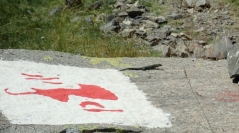

 Naturae
2024 (6) - Pages 105-119
Naturae
2024 (6) - Pages 105-119Endemic to the Pyrenees, the Pyrenean Rock Lizard Iberolacerta bonnali (Lantz, 1927) is a major species for the Pyrenees National Park (PNP), which detained nearly 40 % of its global distribution. Climate change is a proven threat to this species, dependent on the rocky environments of the alpine and subalpine zones of the Pyrenees mountain range. At the request of the PNP, a long-term monitoring protocol has been implemented to assess, in the future, the spatial and temporal evolution of populations of Pyrenean Rock Lizard, in a context of climate change which promotes a rise of Common Wall Lizard Podarcis muralis (Laurenti, 1768). For that purpose, 123 plots with an average of 1000 m² were positioned in 11 study sectors, covering a large part of the French spatial and altitudinal distribution of the species. These plots were surveyed over three 15-minute periods by a set of observers during the lizard season activity. All the observers took part in the field observations after practical and theoretical training in the detection and recognition of the two species of lizards to improve reliability. Lizards abondance records in the plots were analyzed applying the N-Mixture method proposed in the early 2000 s by MacKenzie, Royle and Nichols. The altitudinal distribution varies significantly between the two species of lizards. Pyrenean Rock Lizard is more common in the subalpine zone while Common Wall Lizard is very common in the montane zone and in the lower part of the subalpine zone. The detection time of an individual on the plots occupied by the Pyrenean Rock Lizard is short (on average 4.18 mins) which validates the choice to restrict to three 15-minute periods of prospecting. Modeling of factors influencing abundance of the Pyrenean Rock Lizard shows that some characteristics take a leading role: size of boulders, abundance of herbaceous, type of rock and presence of the Common Wall Lizard. The estimated mean density (λ) is 5.68 Pyrenean Rock Lizards per plot (SD = 1.83) and the estimated population size of all plots is 701 individuals (95% CI = 582.3 – 843.9). This allows to estimate an average occupancy rate of around 0.81, and an average probability of detecting the species between 0.76 and 0.85. The two years of testing show that the method is well suited to the objectives pursued as well as to the material constraints formulated by the PNP. The protocol established will be renewed by the PNP every five years, given the dynamics of Pyrenean Rock Lizard observed on certain sites and human resources that can be spent in this long-term monitoring. A regular training of actors of this monitoring is also required to sustain the experience acquired. This should enable to evaluate evolution of Pyrenean Rock Lizard populations spatially and temporally, in response to effects of climate change and progression of the Common Wall Lizard at lower altitudes of its distribution.
Climatic change, N-mixture